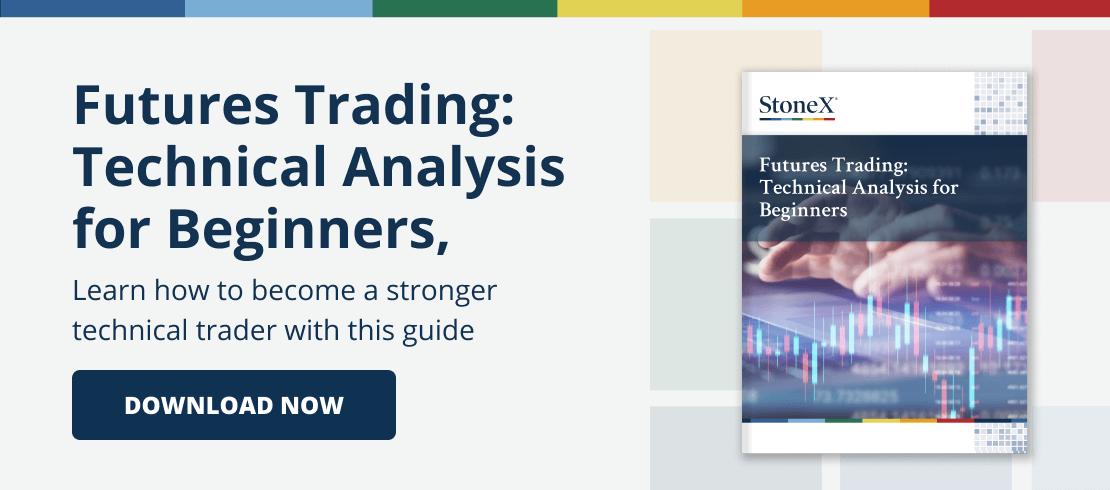Relative Strength Index
The Relative Strength Index, developed by Welles Wilder is a special form of the Momentum and probably the most widely used contra-trend-oscillator. Contrary to the implications of its name, the study does not show the instrument’s strength in comparison to other instruments, but rather the instrument’s internal strength compared to its former prices.
The RSI is calculated in several steps: within a given period, the individual differences between the upward closing prices (Close today > Close yesterday) and downward closing prices (Close today < Close yesterday) are added up and afterwards divided by the number of observations minus one. The result is the day’s mean value of the upward and downward strength of the underlying instrument. Thereafter, the relative strength is calculated by dividing the average upward strength by the average downward strength. Finally, you arrive at the RSI by subtracting from 100 the quotient of 100 divided by 1 plus relative strength.
Properties
Period. The number of bars in a chart. If the chart displays daily data, then period denotes days; in weekly charts, the period will stand for weeks, and so on. The application uses a default of 14, which is a value used by Wilder in calculating the RSI. Meanwhile, other values, in particular 9, 11, and 25 days have become common. The shorter the Period, the calculation, the more volatile the study.
Aspect: The Symbol field on which the study will be calculated. Field is set to “Default”, which, when viewing a chart for a specific symbol, is the same as “Close”.
Interpretation
The main purpose of the RSI is to measure the market’s strength and weakness. A high RSI, above 70, suggests an overbought or weakening bull market. Conversely, a low RSI, below 30, implies an oversold market or dying bear market. Additionally, the value of 50, can serve the same purpose as the zero line in other oscillators. The slowing down of a current trend or a trend reversal may be signaled by crossing above or below 50.
Selling when the RSI is above 70 or buying when the RSI is below 30 can be an expensive trading system. A move to those levels is a signal that market conditions are ripe for a market top or bottom. It does not indicate a top or a bottom. A failure swing or divergence accompanies your best trading signals.
While the RSI can be used as an overbought and oversold study, it works best when a failure swing occurs between the RSI and market prices. For example, the market makes new highs after a bull market setback, but he RSI fails to exceed its previous highs.
Another use of the RSI is divergence. Market prices continue to move higher/lower while the RSI fails to move higher/lower during the same time period. Divergences may occur in a few trading intervals, but true range divergence usually requires a lengthy time frame, perhaps as much as 20 to 60 trading intervals. When the RSI begins to fall below the trough formed by a double-top, this may indicate a trend reversal and a buy signal. A double-bottom in the RSI with penetration upward may signal an opposite trend reversal and a sell signal.
The RSI exhibits chart formations as well. Common bar chart formations readily appear on the RSI study. They are trendlines, pennants, flags, head and shoulders, double tops and bottoms, and triangles. Plus, the study can highlight support and resistance zones. Support and resistance zones often show up clearly on the RSI before becoming clear on the bar chart. Many analysts draw support and resistance lines based on the RSI in the same manner as they would draw trendlines on a chart.
The daily bar chart is the most common chart expression for the RSI. In addition, you may plot a weekly chart to confirm the RSI indications on a daily chart; weekly charts offer more significance when tracking trending activity.
Literature
Wilder, J. Welles. New Concepts in Technical Trading Systems. Greensboro, NC: Trend Research, 1978.
Murphy, John J. Technical Analysis of the Futures Markets. New York Institute of Finance. Englewood Cliffs, NJ. 1986.
Murphy, John J. The Visual Investor. New York, NY: John Wiley & Sons, Inc. 1996.
Spot Relative Strength Index Faster. Futures, January, 1982, p. 76.
Pring, Martin J. Technical Analysis Explained.
Pring, Martin J. On Market Momentum. 1993.
Le Beau C., Lucas D. W. Computer Analysis of the Futures Market. 1992.
Colby, Robert F., Myers, Thomas A. The Encyclopedia of Technical Market Indicators. Dow Jones – Irwin. Homewood, IL. 1988.
Kaufman, Perry J. The New Commodity Trading System and Methods. 1987.
Babcock, Bruce. The Dow Jones – Irwing Guide to Trading Systems. 1989.
View Other Technical Analysis Studies
- Bollinger Bands
- Commodity Channel Index
- Crack Spread
- Crush Spread
- Default
- Directional Movement Index
- Envelope
- Exponential Moving Average
- Exponential Oscillator
- High Low Moving Average
- Highest High / Lowest Low
- Historic Volatility
- Keltner Channel
- Least Squares Linear Regression
- Line Oscillator
- Momentum
- Moving Average
- Moving Average Convergence Divergence
- Moving Standard Deviation
- Open Interest
- Oscillator
- Parabolic Stop and Reversal
- Rate of Change
- Relative Strength Index
- Smoothed Moving Average
- Smoothed Oscillator
- Stochastic
- Variable Moving Average
- Volume
- Volume and Open Interest
- Weighted Close
- What is the Slow Stochastic Oscillator?
- Williams’ %R

